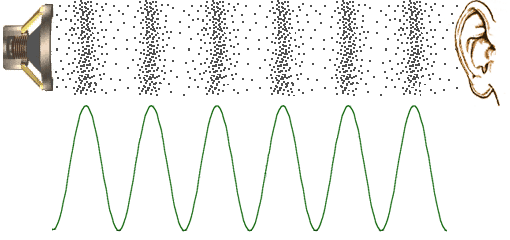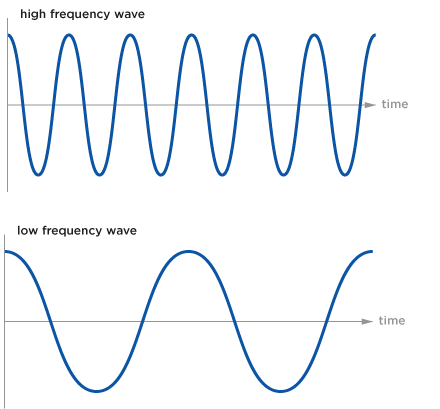Waves
We were taught about two different waves in our sound class, the Transverse Wave, and the Longitudinal Wave.

The Transverse Wave is where the crest (the raised bit) travels perpendicular to the direction of oscillation (movement back and forth in a regular rhythm), which creates a wave. For example, you see a Transverse Wave when you make a ripple in a still lake, or when you jump on a trampoline.
Sound is carried in the form of Longitudinal Waves, (also known as Compression Waves) which are all about particle vibrations. When music comes out of your speaker, it is vibrating the particles around it, and causes them to bump into each other; and then those ones bump into the next ones, and so on (as seen in the slinky example above), until they reach your eardrums, which process the vibrating waves, and allow you to hear that sweet yodelling guilty pleasure of yours.
Basically, the main difference between them is that the particles in a Transverse Wave move up and down, in a wave-like motion, but with Longitudinal Waves, particles just bump into each other, causing a domino-like effect of waves of compressing particles flying out from the oscillator.
But we use the diagram of a Transverse Wave to draw sound, because it is a lot easier than actually drawing the compression of particles. Here is an example of how Longitudinal Waves are drawn.

The more compressed the particles are, the louder the sound.
Amplitude
Amplitude is the distance that the crest (highest point of the wave) and trough (lowest point of the wave) are from the equilibrium (the horizontal middle line) which represents no movement of particles, and therefore no sound. When talking about this distance, we say large amplitude (greater distance) and small amplitude (less distance). The greater the amplitude, the louder the sound, and the smaller the amplitude, the quieter the sound. Here’s a neat little diagram.

Frequency
Frequency basically just means how many cycles a sound has per second. Okay, before you freak out about not knowing what the heck a cycle is, a cycle is a unit of frequency called a hertz. One hertz (written as 1Hz) is basically just when the compression of particles returns to the equilibrium. The wave diagram represents this single cycle as the line of the wave goes up from the middle line to the crest, down to the trough, and back to the equilibrium line once again.

When there are a lot of cycles a second, it is known as high frequency, and when there are fewer, it is known as low frequency. The more hertz there are per second, the higher the pitch of the sound will be.

Okay, so 1Hz means one cycle a second, 2Hz means two cycles, 3Hz means three, and so on. When there are one thousand cycles a second, it is called one kilohertz (1KHz). When there are one million, it is one megahertz, (1MHz) one thousand MHz is gigahertz, (1GHz) one thousand GHz is terehertz, (1THz). The list goes on, but neither of us really need to know about them at this point.
Young people can hear frequencies between 20Hz and 20KHz, and the prime age for hearing in males is about 19, and 21 for females. But as people get older, they lose some of the cells that are responsible for picking up the sound vibrations, and lose the ability to be able to hear higher pitched sounds. Older people’s hearing ranges from 20Hz to about 15KHz. But there are some frequencies that humans can’t even hear; infrasonic frequencies are too low in pitch for us to hear, and ultrasonic sounds are too high.
And now, because that was a whole load of really boring and complicated stuff, here’s a cute little Pikachu balloon 🙂

There, ain’t that better?